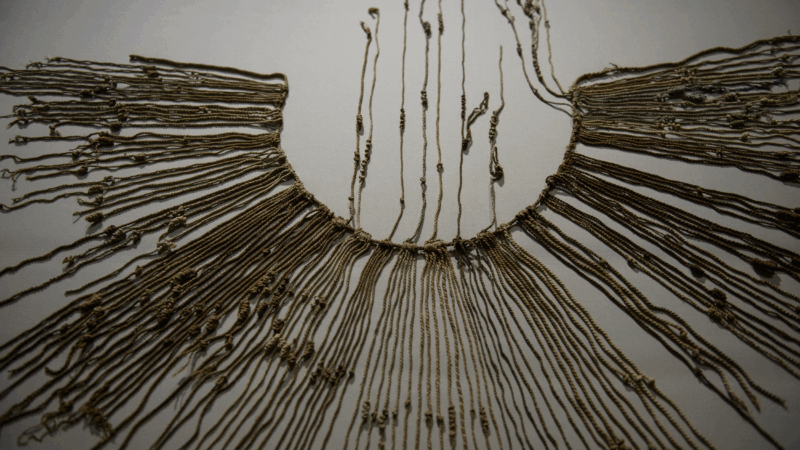A lock of hair may have just changed what we know about life in the Incan Empire
The Inca Empire in South America, one of the most powerful pre-Columbian societies, was known for many innovations — such as the architecture of Machu Picchu, an extensive road network, and a system of terraces for agriculture. Perhaps most unique, though, was the society’s method of keeping records known as khipu, which involves a system of tying knots to encode information.
It’s long been assumed that khipu production was the domain of this civilization’s ruling elites, but a new analysis of a cord made out of human hair finds that even low-class commoners may have engaged in this tradition.
The discovery may help researchers rewrite their understanding of this aspect of Incan civilization, and propel more scientists to test other khipus sitting in museum collections.
“The Incas had the largest empire in the New World at the time. It covered half of a continent, pretty much,” says Sabine Hyland, a researcher with the University of St. Andrews in Scotland, who points out that this massive empire of millions of people relied entirely on knotted cords for keeping records.
The Inca Empire is often cited as the rare exception to the general rule that empires must have a form of written expression, says Kit Lee, a research associate with the university, but this is only because “khipus get overlooked as a form of writing.”
These unusual recording devices are bunches of knots tied in long, colored cords. Typically, cords hang like pendants from one thick primary strand. The Inca Empire was conquered by the Spanish in 1532, and only a tiny percentage of ancient Incan khipus have survived.
Recently, though, Hyland’s university acquired a khipu, and radiocarbon dating indicated that it was from around the year 1498. Hyland initially assumed it was made of hair from animals like llamas or alpacas.
But then she showed it to Lee. “Kit looked at me and said, ‘Sabine, this primary cord is human hair,'” Hyland recalls.

The researchers knew that historically, incorporating hair could serve as a kind of signature that indicated who had made the khipu. And this meant they had an unusual opportunity to find out more about an historic khipu’s creator.
The hairs in this one are about three feet long and represent years of growth. The researchers took samples from each end of a strand and did a lab analysis of elements like carbon and nitrogen, to get clues about what this person must have eaten during their lifetime.
In the journal Science Advances, they and their colleagues report that the hair came from someone who ate legumes, grains, and tubers. They didn’t see evidence of an abundance of meat or maize beer, the typical diet of the ruling class.
While it’s possible that a high-ranking official might choose to not eat meat for some reason, says Hyland, it’s unlikely they could get by without drinking lots of maize beer. “It’s not really possible to escape drinking it,” says Hyland. “Even today, in the Andes, when you participate in rituals, you have to drink what you are given.”
This hair analysis adds another piece of evidence to the growing belief that khipu production and literacy might have been more widespread in the Inca Empire than the Spanish colonizers assumed and recorded in their accounts.
This suggests a relationship between the khipus of the Incan Empire and more modern khipus made from the 1800s to today, says Lee.
“Modern khipus tend to be made by lower-status people — hacienda workers, peasant laborers, herders,” Lee says, explaining that modern khipus tend to have a different shape and structure from ancient ones. Some modern khipus encode agricultural records, while others are buried with loved ones in funeral rites.
“It’s been pretty controversial to draw this continuity between Inca khipus and modern khipus, partly because of the perception that Inca khipus were made by elites,” says Lee.
Manny Medrano, a khipu researcher with Harvard University who was not part of this study, says this study is “unprecedented” in the way it analyzed the hair.
While specialists have long noticed human hair in khipus, he says, this is the only Inca-era one he knows of that has the primary cord entirely made of human hair. “The main cord is really important in khipus,” says Medrano.
Museums hold hundreds of khipus that have never been studied by specialists, he says, and this study is likely to inspire a re-look at ones that have been scrutinized before.
“I would not not be surprised if we find other khipus with substantial amounts of human hair in them in the future,” he says, and that hair might provide a way to understand khipu production in the Inca Empire that’s distinct from the stories written down by colonizers, who may not have fully understood what was really going on.
“Ultimately, this gets us closer to being able to tell Inca histories using Inca sources,” says Medrano. “We need to tell a story of literacy and of writing and of recordkeeping in the Inca Empire that is way more plural, that includes folks who have not been included in the standard narrative.”
‘Bomb cyclone’ forecasted to bring heavy snow, blizzard conditions and dangerous travel
A 'bomb cyclone' is intensifying severe winter weather for millions of people across the U.S. The system is expected to knock out power and disrupt holiday travel.
Russia sends 3 Iranian satellites into orbit, report says
The report said that a Russian rocket sent the satellites on Sunday from a launchpad in eastern Russia.
Viral global TikToks: A twist on soccer, Tanzania’s Charlie Chaplin, hope in Gaza
TikToks are everywhere (well, except countries like Australia and India, where they've been banned.) We talk to the creators of some of the year's most popular reels from the Global South.
This painting is missing. Do you have it?
An important work from a rediscovered artist has been absent from public view since the 1970s. A New York curator is hunting for it.
Memory loss: As AI gobbles up chips, prices for devices may rise
Demand for memory chips currently exceeds supply and there's very little chance of that changing any time soon. More chips for AI means less available for other products such as computers and phones and that could drive up those prices too.
Brigitte Bardot, sex goddess of cinema, has died
Legendary screen siren and animal rights activist Brigitte Bardot has died at age 91. The alluring former model starred in numerous movies, often playing the highly sexualized love interest.








